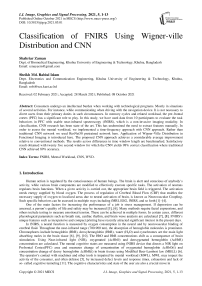Classification of FNIRS Using Wigner-ville Distribution and CNN
Автор: Shahriar Zaman, Sheikh Md. Rabiul Islam
Журнал: International Journal of Image, Graphics and Signal Processing @ijigsp
Статья в выпуске: 5 vol.13, 2021 года.
Бесплатный доступ
Consumers undergo an intellectual burden when working with technological programs. Mostly in situations of several activities. For instance, while communicating when driving with the navigation device. It is not necessary to divert users from their primary duties in such circumstances. In memory cycles and related workload, the pre-frontal cortex (PFC) has a significant role to play. In this study, we have used data from 10 participants to evaluate the task behaviors in PFC with usable near-infrared spectroscopy (fNIRS), which is a non-invasive imaging modality. In classification, CNN research has been state of the art. This has undermined the need to extract features manually. In order to assess the mental workload, we implemented a time-frequency approach with CNN approach. Rather than traditional CNN network we used ResNet50 pretrained network here. Application of Wigner-Ville Distribution in Functional Imaging is introduced here. The proposed CNN approach achieves a considerable average improvement relative to conventional methods. The results across differences in time window length are benchmarked. Satisfactory result obtained with twenty five second window for which the CNN yields 98% correct classification where traditional CNN achieved 89% accuracy.
FNIRS, Mental Workload, CNN, WVD
Короткий адрес: https://sciup.org/15017815
IDR: 15017815 | DOI: 10.5815/ijigsp.2021.05.01
Список литературы Classification of FNIRS Using Wigner-ville Distribution and CNN
- J. Shin and J. Jeong, “Multiclass classification of hemodynamic responses for performance improvement of functional near-infrared spectroscopy-based brain–computer interface,” J. Biomed. Opt., vol. 19, no. 6, p. 067009, Jun. 2014, doi: 10.1117/1.jbo.19.6.067009.
- N. Naseer and K. S. Hong, “fNIRS-based brain-computer interfaces: A review,” Front. Hum. Neurosci., vol. 9, no. JAN, Jan. 2015, doi: 10.3389/fnhum.2015.00003.
- B. Blankertz et al., “The Berlin Brain–Computer Interface: EEG-Based Communication Without Subject Training,” IEEE Trans. Neural Syst. Rehabil. Eng., vol. 14, no. 2, pp. 147–152, Jun. 2006, doi: 10.1109/TNSRE.2006.875557.
- T. Pistohl, T. Ball, A. Schulze-Bonhage, A. Aertsen, and C. Mehring, “Prediction of arm movement trajectories from ECoG-recordings in humans,” J. Neurosci. Methods, vol. 167, no. 1, pp. 105–114, Jan. 2008, doi: 10.1016/j.jneumeth.2007.10.001.
- M. Saadati,J. Nelson, H. Ayaz, ‘Convolutional Neural Network for Hybrid fNIRS-EEG Mental Workload Classification’, In: Ayaz H. (eds) Advances in Neuroergonomics and Cognitive Engineering. AHFE 2019. Advances in Intelligent Systems and Computing, vol 953. Springer, Cham. https://doi.org/10.1007/978-3-030-20473-0_22
- U. Asgher, R. Ahmad, N. Naseer, Y. Ayaz, M. J. Khan, and M. K. Amjad, “Assessment and Classification of Mental Workload in the Prefrontal Cortex (PFC) Using Fixed-Value Modified Beer-Lambert Law,” IEEE Access, vol. 7, pp. 143250–143262, 2019, doi: 10.1109/ACCESS.2019.2944965.
- C. T. Gloria and M. A. Steinhardt, “Relationships Among Positive Emotions, Coping, Resilience and Mental Health,” Stress Heal., vol. 32, no. 2, pp. 145–156, Apr. 2016, doi: 10.1002/smi.2589.
- G. Durantin, J. F. Gagnon, S. Tremblay, and F. Dehais, “Using near infrared spectroscopy and heart rate variability to detect mental overload,” Behav. Brain Res., vol. 259, pp. 16–23, Feb. 2014, doi: 10.1016/j.bbr.2013.10.042.
- F. Jobsis, “Noninvasive, infrared monitoring of cerebral and myocardial oxygen sufficiency and circulatory parameters,” Science (80-. )., vol. 198, no. 4323, pp. 1264–1267, Dec. 1977, doi: 10.1126/science.929199.
- S. Cinciute, “Translating the hemodynamic response: why focused interdisciplinary integration should matter for the future of functional neuroimaging,” PeerJ, vol. 7, p. e6621, Mar. 2019, doi: 10.7717/peerj.6621.
- J. Jarmasz, C. M. Herdman, and K. R. Johannsdottir, “Object-based attention and cognitive tunneling,” J. Exp. Psychol. Appl., vol. 11, no. 1, pp. 3–12, 2005, doi: 10.1037/1076-898X.11.1.3.
- H. Aghajani, M. Garbey, and A. Omurtag, “Measuring mental workload with EEG+fNIRS,” Front. Hum. Neurosci., vol. 11, no. July, pp. 1–20, 2017, doi: 10.3389/fnhum.2017.00359.
- L. Cohen, Time–Frequency Analysis. Prentice-Hall, 1995.
- L. Debnath and F. A. Shah, Wavelet Transforms and Their Applications. Boston, MA: Birkhäuser Boston, 2015.
- Mallat. Stephane, A Wavelet Tour of Signal Processing, 2nd ed.
- S. Hiwa, K. Hanawa, R. Tamura, K. Hachisuka, and T. Hiroyasu, “Analyzing brain functions by subject classification of functional near-infrared spectroscopy data using convolutional neural networks analysis,” Comput. Intell. Neurosci., vol. 2016, 2016, doi: 10.1155/2016/1841945.
- C. Herff, D. Heger, O. Fortmann, J. Hennrich, F. Putze, and T. Schultz, “Mental workload during n-back task-quantified in the prefrontal cortex using fNIRS,” Front. Hum. Neurosci., vol. 7, no. JAN, pp. 1–9, 2014, doi: 10.3389/fnhum.2013.00935.
- D. Sajila,W. M. S. Mahmud, ‘A Deep Learning Based Ternary Task Classification System Using Gramian Angular Summation Field in fNIRS Neuroimaging Data’,arViv:2101.05891 [cs.LG],14 Jan,2021


